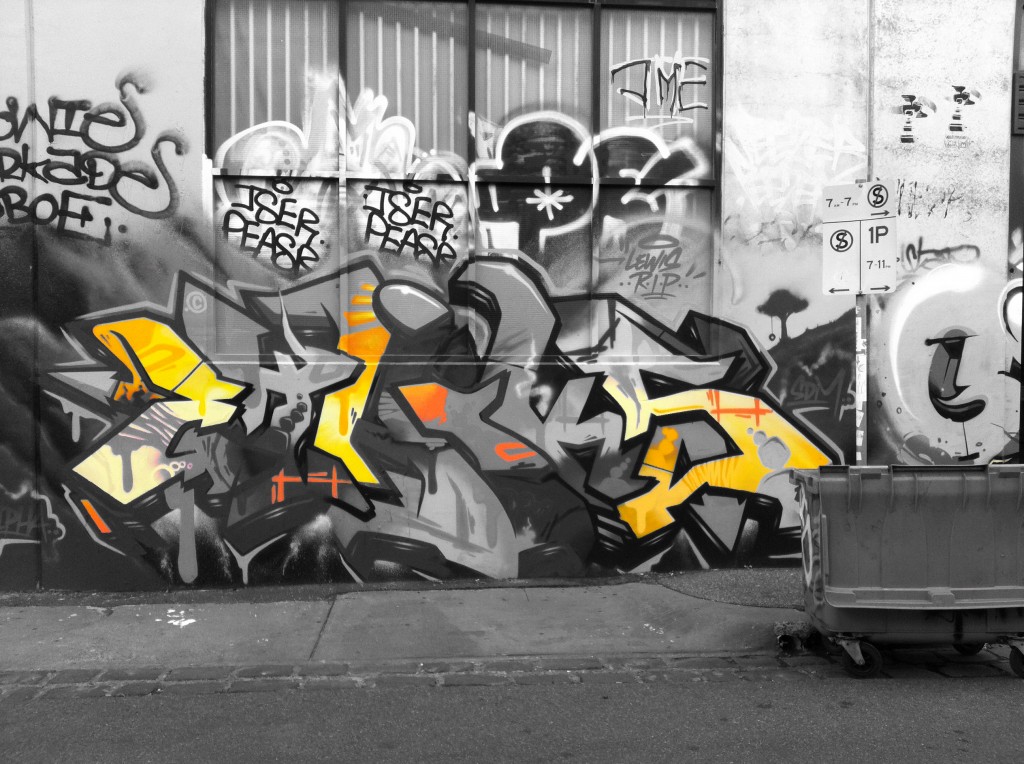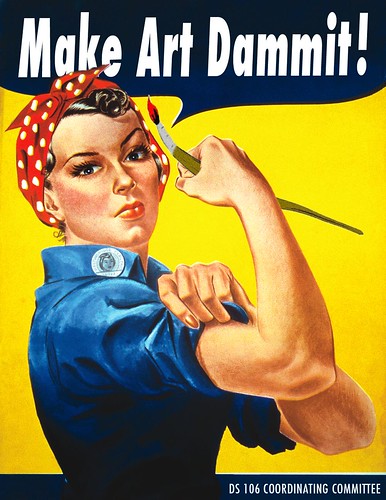For week four of the Open University course on Open Education, we were asked to compare MOOC models: either ds106 or the Change MOOC with something from Coursera or Udacity, focusing on “technology, pedagogy, and general approach and philosophy.”
I decided to go ahead and do this activity (though I’m not doing all of them for the course) because I really want to get a better sense of ds106. Plus, though I’ve explored Coursera a fair bit, and even signed up for one of their courses to see what it’s like being a participant, I haven’t looked at Udacity at all. While I kind of don’t care if I look at Udacity, this activity is a good excuse to look at ds106, which I do care about, and, well, I’ll at least know a bit more about Udacity in case that ever comes in handy.
ds106
“DS” stands for digital storytelling, and this course began in 2010, started by Jim Groom at the University of Mary Washington. It still has students registered officially at UMW, and there are sections at other campuses as well (see “other Spring 2013 courses” at the top of the ds106 site). In addition, it has, well, I have no idea how many other online participants who are participating in parts or all of the course. (There are over 150 blogs listed in the “open online participants” section, but that may not be the same as the number of people who are actually participating. And that doesn’t count the on-campus students.)
One thing that stands out about ds106, among many others, is that while it’s a course that has specific beginning and end times for on-campus participants, it explicitly invites anyone to drop in anytime they like and stay for as long (or as short) as they like. Some people may be participating in a fairly in-depth way, by setting up blogs that are syndicated on the site, while others may just do a few assignments here and there (thus, the near-impossibility of figuring out how many people are actually “participating” at any given time).
Ways of participating in ds106 (for open online participants)
1. “The daily create“: a low-key, low-commitment, super fun way to participate. Every day there is a new suggestion to create something, and anyone can do one or more of these and add them to the collection. The daily create site explains:
The daily create provides a space for regular practice of spontaneous creativity through challenges published every day. Each assignment should take no more than 15-20 minutes. There are no registrations, no prizes, just a community of people producing art daily.
For example, today’s daily create (April 21, 2013) is: “Take a photograph of something you must see everyday. Make it look like something else!” Once it’s done you simply upload it to Flickr with some specific tags, and voilà, they show up on the daily create site (well, barring some technical hiccups and such). You can also search Flickr for the specific tag for today and find all the creations. Utterly cool.
I decided to do the Daily Creates for April 21 and 22, and had much fun with them. You can see my photos here and here. (I’ve got a lot of work to do on the “creative” end of things.)
2. Do some assignments from the “open assignment bank.” According to the “about” page for the assignments, they are all created by ds106 students. Those who are taking the course in a formal sense on a campus don’t need to do all the same assignments–they can pick and choose in order to put together those that will equal a certain number of “points” for a topic in the course. And anyone can do any one or more of the assignments, anytime they like. One can either do them on one’s blog and register it with the blog aggregator, or upload it to the site directly.
3. Don’t just do the assignments, write about them in a blog. Tell a story about why you chose that assignment, the context of what you created, and how you did it so others can see the process. Then, connect your blog to the ds106 hub so it shows up here. Further, read some posts from others’ blogs and comment. Build community.
4. Follow along with an on-campus course. You could look at the posts from a particular on-campus course (see top menu of ds106 site) and do similar topics as they are, and comment on their blogs/assignments.
This is all in addition to following ds106 on Twitter through the #ds106 hashtag.
And really, what other “course” has its own radio station? The most amazing thing about it is that it’s open to anyone to broadcast on, so far as I can tell. Well, anyone who can figure out how to do it. Find out what’s on by following @ds106radio or the #ds106radio hashtag on Twitter.
And there’s a “tv” station too, though I’m not sure how it works. I just know I got a tweet about an upcoming presentation, and when I clicked on the tv station site I could watch the presentation. Seems to be an option for live chat, too. You can follow @ds106tv or the #ds106tv hashtag on Twitter.
Udacity: “Elementary Statistics”
At some point I need to learn some statistics for my work in the Scholarship of Teaching and Learning. So I decided to take a look at Udacity’s “Elementary Statistics” course, for possibly doing it later.
General observations
Starting off with the main Udacity “How it works” page, I find something suspicious:
The lecture is dead
Bite-sized videos make learning fun
My experience with Coursera was that the traditional, hour-or-so-long lecture format seemed to just be cut up into shorter pieces, with a talking head talking for, if I remember correctly, 10-15 minutes at a time, interspersed by quizzes or other activities. We were still supposed to watch all the pieces. That’s not what I’d call killing the lecture: a lecture is still a lecture, no matter how short it is. This point has been made countless times before (here is just one example, from the excellent “More or Less Bunk” blog by Jonathan Rees). The lecture is dead. Long live the (mini) lecture. So I’m right away wondering whether Udacity is going to be any different on this point.
And I really, really don’t like the “branding” they do: they call us “Udacians” (Coursera calls participants “Courserians”), and they have their own new word–see, e.g., here. Yuck. It really puts me off. I don’t mind the sense of identity I got through doing ETMOOC, a sense of community, of belonging to something. I think it’s because the latter was developed over time, rather than foisted upon people when they start; with Udacity I feel like I’m being told I’m part of a community in order to put me into a feeling of caring about the company, rather than letting that feeling develop over time (if at all).
About the course front page: I hate the fact that I have to actually enroll to see how the course works (unlike ds106, in which all elements are out there for anyone to see and start doing). No wonder these kinds of MOOCs have such large enrollment numbers. You have to enroll just to see the thing in the first place.
Why do they require a registration before you can get a real sense of a course? At the very least, they can keep track of people that way to send them marketing materials. And they can gather a bunch of data about participants–all one’s courses, all one’s work inside those courses, can be tracked if they can attach work in the course to specific people. Which makes me wonder: what is that data being used for, exactly? The privacy policy doesn’t answer that question fully:
We use the Personally Identifiable Information that we collect from you when you participate in an online course through the Website for managing and processing purposes, including but not limited to tracking attendance, progress and completion of an online course.
But what do they do with the information about progress in courses, besides store it so you can go back to the course later and see how much you’ve done, or use it to issue certificates? Well, here’s one answer: it’s being used to make money. Udacity and similar companies can identify students who might be good matches for employers, and the employers can pay for the service.
But I wonder if any of this data could be used to provide useful information on online teaching and learning. Maybe, maybe not, but we may never know unless researchers can get access to the data. (Mike Caulfield explains here that institutions that are partnered with Coursera can get at least some data, but I don’t know what Udacity’s policies are in this regard.)
Nor do I expect that I, as a participant, will have detailed access to my data, because I don’t own it; they do–a problem discussed by Audrey Watters, here (and in a great presentation for ETMOOC, linked here).
I decide to register for an account and take a deeper look at the course–because really, I want to see how they killed the lecture.
Starting the course
The course goes right away into a short (>2 min) introductory video, and I pretty quickly get the hang of how this course works: very short videos (0-2 mins, some 30-45 secs long) followed by quick quiz questions (multiple-choice, fill in the blank, that sort of machine-gradable thing), back and forth for each “lesson” (though some video segments don’t have quiz questions attached). At the end of each lesson there is a problem set. And so it goes, for 12 lessons.
One nice thing is that there is a link to forum questions connected to each of the short videos, because if you go to the main forum page, you just get a bunch of discussions that aren’t clearly organized by topic or lesson. You can organize them by tags, but you have to know what the tags are to do a search on them. Another nice thing is that for each video you can click on the “ask a question” button, and it automatically adds the right tags for you for that particular video segment.
I skipped ahead to the first problem set and tried to do some of them, just to see what they’re like. All multiple choice, and like the “quizzes” in the lessons, you are told right away if your answer is right or wrong. In the quizzes you can just skip ahead to the answer if you can’t figure it out; not so in the problem sets. You have to keep trying until you get it right (a process of elimination, in may cases) or just skip the question. Or, you can always take a look at the discussion forums, where I found that sometimes someone had helpfully posted the answers.
Apparently there will be a final exam, but it won’t be ready online until May (not all the lessons are ready yet, either).
Is the lecture dead?
Yes and no.
The course does a great job of mixing lecture with participant activities, such as short quizzes to apply what’s just been said, or sending you to third-party sites to do activities there. In the first lesson, they sent us to do a face memory test from the BBC, and then asked us to put our scores into a Google form. Much of the rest of the first lesson referred back to this test and how one might think about the data generated by it. That’s a nice way to use an example for a stats lesson.
I didn’t make it all the way to the end of the first lesson, but if I had, I might see what they are actually doing with the data generated by student participants who take the test and upload their scores into the Google form. What’s it being used for? I think it’s uploaded anonymously, but I’m not sure because you access the form through the course interface itself. Hmmmmm.
[And if my BBC face test data was connected to my personally identifiable information, then I should have had to fill out a consent form for it to be used, right? Might they have gotten ethics approval to collect such data? Or maybe they don’t need to? The important thing here is that none of these questions are answered, even the question of whether my Google form data had identifiable information on it. I just don’t know.]
The videos still contain lectures, but they are so short as to hardly seem such; often there is a quiz every 30 secs to 1 minute (sometimes longer, but not much). So there is a good deal of participant activity going on as well (one might even call it a form of “active learning”). And the videos for this course are (mostly) not face shots of instructors talking, but rather some kind of digital whiteboard with text and diagrams.
One could say these aren’t like lectures because they are so interspersed with participants having to do something. But the pedagogical approach that underpins lecturing is still in evidence, namely the knowledge/information transmission approach (more on this, below). So in some sense, there are still lectures here; they are just very, very short.
I tend to think there’s nothing wrong with having some lecturing going on here and there, though I’m also rather drawn to Jacques Rancière’s The Ignorant Schoolmaster, which can be read as suggesting that one ought not to act an expert and engage in explaining things to learners at all (see, e.g., the section on “Emancipatory Method” here, and the nice summary by my colleague Jon Beasley-Murray here, along with a critique I have to think about further).
I expect Udacity means that “the hour-long lecture, without participant activities to break it up” is dead (which, of course, it’s not, but that’s another matter). But the “expert” as transmitter of knowledge to be grasped, and the “learner” as taking on that knowledge in exactly the same way as the expert, is not.
Technology
The most striking difference in terms of technology is this. For the Udacity course, there is some pretty heavy technological investment going into the production of the course. The videos are not just recordings of professors talking, but often of a digital board that one of the instructors writes on with a stylus, in different colours. The video switches fairly seamlessly into a quiz: the quiz looks just like what was last seen on the video, but when you move to it suddenly click boxes appear, and suddenly you’re in interactive mode. The technological structure of the course may not be terribly complicated (what do I know about such things? pretty much nothing), but my point is that the main technological investment is happening at the “course” side.
What’s different about ds106 is that the participants themselves create things with technology, with software and applications, rather than being consumers of such products produced by those in charge of the course. Instead of just passively interacting with things made by others, ds106 participants learn how to use technology to create their own artifacts. Just a quick glance at the Assignment Bank or The Daily Create shows that course participation is heavily focused on making things rather than (only) taking in knowledge from others. As does the fact that all the assignments (and at least some, or many, of The Daily Creates) are created by course participants.
Pedagogy and philosophy
Making and replicating
The above point about different uses of technology in the Udacity course vs. ds106 reminds me of some things George Siemens said about the difference between “xMOOCs,” like those from Udacity and Coursera, and “cMOOCs,” or connectivist MOOCs, like ETMOOC and Change 11 (I discuss some of the differences in an earlier blog post). He states here that
Our MOOC model [cMOOC] emphasizes creation, creativity, autonomy, and social networked learning. The Coursera model emphasizes a more traditional learning approach through video presentations and short quizzes and testing. Put another way, cMOOCs focus on knowledge creation and generation whereas xMOOCs focus on knowledge duplication.
Is ds106 a cMOOC? It does have the focus on creating over duplication. Alan Levine argues that it’s not a MOOC at all:
To me, all other MOOCs, be they x or c type, sis [sic] to create the same content/curriculum for everyone in the course- they all do the same tasks. And to be honest, the framing points are actually weekly lectures, be they videos spawned out of xMOOCs or webinars. The instruction in these modes are teacher centric (even if people can banter in chat boxes).
Should we say that’s the definitive answer to the question? I don’t know, and really, it doesn’t matter in the end. But Levine has a point about other open online courses being more focused on weekly presentations (ETMOOC was like this) and having the same general topics for all each week, even if there aren’t always common assignments given to everyone (there weren’t in ETMOOC). ETMOOC was also more of a set “event” happening at a certain time (though, thankfully, many of us are continuing to think and discuss and work together afterwards on a “blog reading group”). ds106 is even less structured than that, being something one can participate in anytime, an ongoing community more than a course–except for those who are taking it as part of an official educational program, that is.
The Udacity course on statistics definitely holds to a model of knowledge duplication, in which participants learn things from experts and duplicate that knowledge on quizzes and problem sets. This is not surprising, given the topic, and not really a problem, given the topic. I found it more problematic when looking at a Coursera course on critical thinking and argumentation.
For all that, though, the Udacity course doesn’t encourage passivity in participants; one is continually doing things with the information being presented, instead of mainly watching or listening. It’s just that one isn’t really making or creating new artifacts, new knowledge in these activities, things to be contributed back to the community of learners. Except, of course, on the discussion forums, which are not really integral to the course. You can go to them if you have a question, or want to see answers to others’ questions, or want to answer others’ questions, but I think you can do the whole course without ever going to the forums.
Philosophy
I’m not familiar enough with educational theories to be able to say much of anything scholarly here, so I’ll just make a couple of quick observations that risk being so general as to caricature the approaches in these two online experiences.
In the Udacity course, the philosophical approach has already been stated above: a kind of expert-transmission model. The instructors are experts who should explain the topics in a way that will work for the most participants possible. There can be no adjustment in the instruction for different participants, as it must necessarily be the same for all in the main presentations and quizzes (though it can be altered over time, if evidence suggests a need for it). The assumption has to be that there can be a way to reach at least a good portion of a mass audience of learners, through clarity of presentation and testing of understanding along the way. If this doesn’t work for some people, they can hopefully get help through the forums (which have contributions from both participants and, at times, the instructors).
The learning experience is, from what I experienced in the first lesson and problem set, entirely instructor-directed, with the participants going through an already-set and -structured path through the course. It is possible to earn a certificate for a course, according to the FAQ page, if you complete a certain number of “mastery questions” correctly and thus achieve at least a certain “mastery level.” In this case, “mastery” means being able to replicate the knowledge one has ingested.
ds106, by contrast, (at least for open, online participants) is participant-directed rather than instructor-directed. Participants decide what they want to do, and when. There is no indication that one ought to follow a pre-set path through the course, nor that one should try to work through most or all of the topics.
The instructors in ds106 are not acting as “experts” for the open participants. There is nothing in the way of information being given to participants that they must somehow return back in the same form. There is only the ds106 handbook, which provides advice and tips for using digital tools as well for blogging about one’s artifacts, but participants then create their own artifacts and knowledge with those tools. Indeed, the “experts” in ds106 are not the instructors, at least for the open participants–it’s really the other students. They are the ones producing the artifacts, creating the assignments, and commenting on each others’ work and blogs.
Better?
It’s no secret on this blog that I prefer the “cMOOC” structure to the xMOOC one. Generally I prefer providing students with more freedom to investigate things they find to be engaging and valuable than to tell them exactly what they should do in order to “learn.” (Though my reservations about rhizomatic learning are also relevant here).
So it would probably seem that I’d prefer ds106 to the Udacity course. Which I do. I really appreciate that the “course” is about what participants can create rather than about what experts have to tell them.
But there just are some things that lend themselves okay well to the expert, knowledge-dissemination model, like basic statistics. That’s not to say that I don’t think participants can add important critical and creative knowledge to the field of stats, but at the start, one has to just grasp some of the basic concepts in order to understand the field well enough to do so. Or at least, to talk to others in the field about one’s ideas. And Udacity does a fairly good job of that, from what I’ve seen.
I expect I’d have a different response to a Udacity-type course in philosophy, however.













